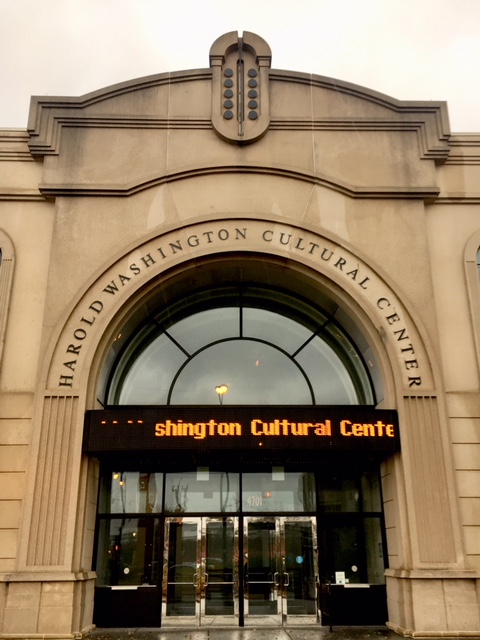What’s That Building? 8 Sites Named After Mayor Harold Washington
More buildings and parks in the city are named after Washington than any other mayor. Washington died 30 years ago this week.
By Meha Ahmad, WBEZ Staff

What’s That Building? 8 Sites Named After Mayor Harold Washington
More buildings and parks in the city are named after Washington than any other mayor. Washington died 30 years ago this week.
By Meha Ahmad, WBEZ StaffIn his first inaugural address as Chicago mayor in April 1983, Harold Washington said he’d like to be “remembered by history as the mayor who cared about people and who was, above all, fair.” Those words are emblazoned on a plaque next to the front door of one of the most substantial memorials to the late mayor — the city’s main library on State Street in the South Loop.
Not including the many murals, posters, and museum exhibits that honor Washington, who was Chicago’s first African-American mayor, there are eight buildings and parks named for the late mayor — more than any other former mayor of Chicago.
From a playground for small children to a college to apartments for seniors, sites named after Washington span the city, from Roseland on the South Side to the North Side’s Rogers Park. Crain’s Chicago Business reporter Dennis Rodkin talks about these sites and how they relate to the late mayor’s vision for Chicago.
1. Harold Washington Memorial Park, 7710 N. Paulina St.

In 1983, a community-development group in a troubled section of Rogers Park located north of Howard Street created a tot lot on an empty piece of ground. The playground was part of a larger effort to help revive the neighborhood and attract businesses along Howard Street. In his first year in office as mayor, Washington helped cut the ribbon to open the park, which later was renamed in his memory.
2. Harold Washington Apartments, 4946 N. Sheridan Road

In 1986, a group called Mercy Housing redeveloped a decaying structure from 1916 at Sheridan Road and Argyle Street in Uptown for low-income housing. The beautiful, three-story building has a handsome brick upper portion with extruded beams supporting a clay tile roof. The first floor includes retail on both streets. Mercy Housing operates 65 studios and four one-bedroom apartments in the building that it later named for Washington, who supported the group’s efforts.
3. Harold Washington College, 30 E. Lake St.

Six days after Washington died, the board of City Colleges of Chicago voted unanimously to rename the 25-year-old college, located in the Loop, in his honor. At the same time, the board renamed its academic scholarships for students at all nine campuses in his honor, too.
4. Harold Washington Social Security Center, 600 W. Madison St.

This 10-story building owned by the federal government was completed in 1975 and renamed in Washington’s memory in the first few months after his death. It serves as a reminder that before becoming mayor of Chicago, Washington served in Congress for two years after 16 years in the state legislature.
5. Harold Washington Library Center, 400 S. State St.

On July 29, 1987, Washington and the City Council launched a design-build competition for the city’s new main library, which would be built at State and Congress at the cost of $144 million. Washington died just four months later, and when the 10-story library was completed in October 1991, it was dedicated in his name.
6. Harold Washington Cultural Center, 4701 S. Martin Luther King Drive

The Harold Washington Cultural Center is an arts training and performing arts facility with a 1,000-seat auditorium. It opened in 2004 after more than 15 years of efforts to build a theater on a corner that had been empty since the legendary Regal Theater was demolished in 1973.
It was originally going to be named for Chicago-born singer Lou Rawls, but in 2001, a spokesman for Rawls told the Chicago Tribune that Ald. Dorothy Tillman (3rd Ward), who was spearheading the project, had dropped Rawls from the project without telling him.
The next year, Tillman, announced it would be named after Washington instead, and a statue of him now stands out front.
The center, which Tillman envisioned as the spark for a new blues and entertainment district, has struggled. It was hit with a foreclosure suit in 2010, but it remains open and serves 25,000 people a year through its various arts training programs and performances, according to its website. In December, it’s hosting performances of The Nutcracker.
7. Harold Washington Playlot Park, 5200 S Hyde Park Blvd.

The second city park named after Washington is in the neighborhood where he lived. It’s 10 acres along the inland side of Lake Shore Drive between Hyde Park Boulevard and 53rd Street. It includes tennis courts, a playground, and a concrete pond. The park district renamed it from East End Park to Harold Washington Park in 1992.
8. Harold Washington Hall, Chicago State University at 95th St. and Martin Luther King Drive

Originally called the Arts & Sciences Building, the Harold Washington building at Chicago State University was built in the early 1970s as one of the first five buildings on their new campus. In September 1988, it was renamed for Washington, who had campaigned for mayor on campus and was a friend and political ally of the school’s president, Dr. George Ayers.
Washington was part of a group that went with Ayers to Nigeria in 1984 to set up a program to bring Nigerian students to Chicago State. Three years later, Ayers was part of the summit group that Washington set up to write a comprehensive school-reform plan. The building now houses several departments, including criminal justice, English, and math.
